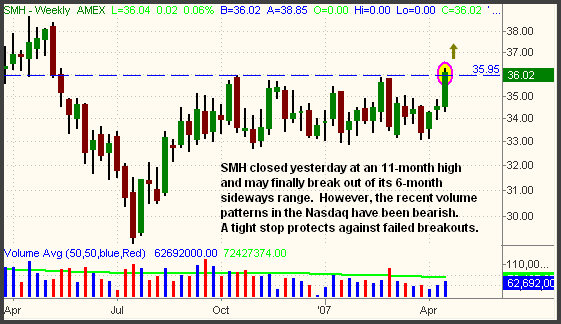| The Wagner Daily ETF Report for April 20 |
| By Deron Wagner |
Published
04/20/2007
|
Stocks
|
Unrated
|
|
|
|
The Wagner Daily ETF Report for April 20
Just as it did on February 27, Thursday's loss in the Shanghai market led to a large opening gap down in the U.S. markets yesterday morning. But unlike the last time, stocks immediately reversed and trended higher throughout the first half of the session. Although each of the major indices touched positive territory just after mid-day, subsequent afternoon selling caused most stocks to finish modestly lower. The S&P 500 and Nasdaq Composite were lower by 0.1% and 0.2% respectively, while the Dow Jones Industrial Average was unchanged. Continuing the pattern of the past several days, small and mid-cap stocks posted the largest losses. The Russell 2000 slid 0.6% and the S&P Midcap 400 fell 0.4%. Most of the major stock market indexes finished near the middle of their intraday ranges, pointing to indecision into the close.
Not to sound like a broken record, but the biggest problem with yesterday's session was once again the bearish volume patterns. In both exchanges, total volume increased by 2% over the previous day's level. The losses on higher volume caused the Nasdaq to register another bearish "distribution day," its fourth such day of institutional selling within the past seven sessions. An occasional day of higher volume losses is normal within the context of a healthy market. However, rallies typically run out of gas when faced with four or more "distribution days" within a rolling four-week period. Nevertheless, the volume patterns in the NYSE have been more positive. The S&P has had only two "distribution days" within the past four weeks.
The Semiconductor Index ($SOX), which has been stuck in a choppy, sideways range for the past six months, is beginning to show signs of life. While the Nasdaq has moved lower over the past two days, the $SOX has moved higher. The Semiconductor HOLDR (SMH) has moved higher as well, and actually closed yesterday above its sideways range and finished at an 11-month high:

We hesitate to label it a confirmed breakout just yet, as SMH has failed all other breakout attempts over the past six months. Still, it is showing a lot of strength over the past several days and may finally move out of its range for more than a day or two. The only thing keeping our excitement in check is the recent distribution in the Nasdaq. Yet, the $SOX is not the valid leading indicator of the Nasdaq that it used to be. Rather, the Nasdaq has become more closely correlated to the direction of the small-cap Russell 2000 Index. We'll be stalking SMH for a potential long entry over the next few days, though we are a bit hesitant to buy unless the Nasdaq starts acting better.
Recently, a subscriber brought to our attention a change in the regular market hours for the StreetTRACKS Gold Trust (GLD). Rather than opening at 9:30 am ET with the rest of the markets, GLD now opens at 8:20 am ET. This is different than the regular pre-market trading that has been available for years through ECNs, as this is regular, specialist trading through the NYSE. It's important to be aware of this change because market orders that are submitted overnight are now sent to the floor and executed at 8:20 instead of 9:30. The rationale behind the change is that trading in GLD should commence at the same time as NYMEX trading in gold futures and options. Strangely, it seems the NYSE has done a poor job of getting the word out about this change that began on February 9, 2007.
Although the broad market closed well off its intraday highs, it demonstrated impressive resiliency yesterday. Given how far stocks have rallied off their March lows in such a short period of time, the opening gap down gave traders and investors a perfect excuse to take profits on long positions. Instead, the bulls stepped in and provided support, enabling the S&P and Nasdaq to finish only modestly lower. The Dow even gained less than 0.1%. Under the surface, the Nasdaq's bearish volume patterns are indeed a cause for concern. However, just one "accumulation day" of higher volume gains that pushes the major indices to new highs could be enough to absorb any remaining overhead supply. If the S&P, Nasdaq, and Dow manage to blow off yesterday's bearishness and finish the week at their highs, it would demonstrate just how much the bulls remain in control. Conversely, a close below yesterday's lows would probably lead to a decent correction and set a bearish tone for next week. Because of the mixed signals of bullish price action with bearish volume patterns, we are content to remain mostly in cash, taking a "wait and see" approach.
Deron Wagner is the Founder and Head Trader of both Morpheus Capital LP, a U.S. hedge fund, and Morpheus Trading Group, a trader education firm launched in 2001 that provides daily technical analysis of the leading ETFs and stocks. For a free trial to the full version of The Wagner Daily or to learn about Wagner's other services, visit MorpheusTrading.com or send an e-mail to deron@morpheustrading.com.
|